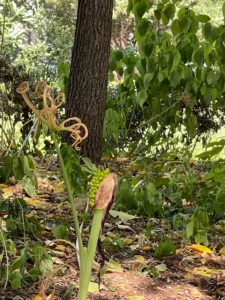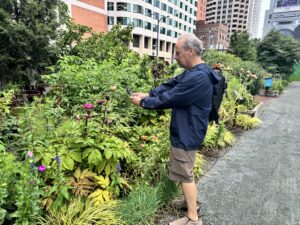Meet John O. Harney, a dedicated Phenology volunteer of the Greenway Conservancy and avid writer! After more than 30 years as the Executive Editor of The New England Journal of Higher Education, John put down his pen and looked forward to a retirement of watching over the plants on the Rose Kennedy Greenway. He decided to join our Phenology Volunteer Program in 2023, and has been an integral asset to the team since. Along with his time tracking bloom cycles of plants in the Dewey Square area of the park, John teaches English at the Immigrant Learning Center in Malden, MA.
We asked John if he would be willing to write a piece for the Conservancy blog, and we’re delighted when he agreed.
If you are interested in learning more about volunteer opportunities on The Greenway, please visit our Volunteers page.
You can read more of John’s blog on his website.

____________
Witnessing Beauty but Wilting in Empathy
By John O. Harney – July 29, 2024

A few sweltering Wednesdays ago, I spent my 12th day of this 2024 season observing blooms on the Rose Kennedy Greenway. The temperature topped 90 degrees for the third day in a row and the eighth day of the previous 11. The plants were wilting. And so was I.
The chief wilters were the white hydrangeas, despite 2024 being widely acclaimed by the media and others as a special year for hydrangeas, at least before the punishing heatwaves.

That roasting Wednesday, the drying, drooping plants and I all looked like we needed a frosty glass of iced compost tea.
For most of my Greenway visits, I’ve enlisted company, either friends of family members. That scorching day, I planned to take the Commuter Rail into Boston’s North Station to meet my wife who was scheduled to arrive in the afternoon at South Station from a trip via Amtrak to New Jersey. People complain understandably about there being no direct rail connection between North and South Stations. But this day seemed perfect for me. I could sneak in my volunteer phenology observations by walking The Greenway between the two train stations and meet my wife for dinner. But Amtrak and Commuter Rail are famously unreliable. And the meetup was not to work.
Arriving from North Station, I explore the Wildlife Meadow near Haymarket, a favorite Greenway section and this week, especially alive with white, yellow, blue and red flowers. The rest of that parcel, Parcel 12 (used effectively last year for sunflowers) was also in new bloom. A few blocks further on, I sample The Greenway’s frequent international flair, grabbing a jerk fish lunch from a pop-up Jamaican food stand and eating it on a Trillium bench with a stranger. It sure beats a crumbling highway.
I’m gearing up for a closer look at “my parcels,” Parcels 21 and 22. Once home, I planned to combine a phone app called PlantNet and Google Photos for IDing purposes. Like a well-meaning teacher, I’m often guilty of grade inflation. Lots of blooms that I give 3s under The Greenway ranking system (3 being essentially peak) probably would be 4s (past peak, headed toward winter vacation) if I were a tougher grader.
In my area of The Greenway, some things are leafing but not flowering: lamb’s ear, wild ginger, rhubarb, ironweed and several violet intruders.
The image of this season on Parcels 21 and 22: showy coneflowers flowering pink and yellow amid passing alliums, whose globes remain partly intact but have lost color (despite the look of an egg yolk-like center recently. A bug perhaps?)

Another star of this season: liliums, as tall as me and flowering crimson and white.
Isolated daylilies are blooming orange, deep bronze and the yellow of Stella D’Oro?
Once vibrant white anemones in the bed along Pearl Street now show stems but no flowers. I’ve learned there are at least two kinds of anemone in my parcels, including one whose flower morphs into a fluffy white top. Interesting, but a 4 by the rating system, I suppose.
Some hostas are flowering pinkish-purplish at the corner of Pearl and Atlantic. I generously rank them 3s, though they still strike me as commonplace suburban landscape plant.
A Magnolia near Pearl and Atlantic is “passed,” no longer imparting heavenly flowers and fragrances, but now showing interesting gourdy-looking white cones.
Astilbes that flowered vibrant pink now mix with some fading brown. In some spots, they nearly merge with the more grand aruncus, which requires me to do a double-take as I ID.
Grape hyacinths are long passed with now-whitish disks where their purple and blue flowers were. Joe Pye weed is soon to come, reaching up like a refined man’s milkweed.
Dicentra is resilient, not the Asian bleeding-heart style with bright fuchsia-pink and white flowers that my mother grew in her garden, but the more common North American native bleeding heart apparent on my Greenway parcels.
I also have a new respect for goldenrod (solidago), after all those years thinking it was up there with ragweed in causing my spring-destroying hay fevers. Alas, many experts now say goldenrod is not the culprit.
The purplish flowers of catmint (nepeta) are fading a bit. Catmint has become something like a lowest common denominator in suburban gardens and strip mall landscapes, but it’s still striking on The Greenway. Also blooming purplish are wild geraniums, macrorrhizum and rozanne, and stokesia. A few meadow phloxes bloom white near the magnificent umbrella pine, with its touchable needles. Baptisia is not flowering but showing blackish buds, a bit like its usual seed case (odd year for my home one too).
Dracunculus, which has caught my eye in various phases, is passed but showing a fascinating pod of pea-like fruit.

Also, beebalm flowers vibrant red—what Greenway folks ID as Monarda Oswego tea. And impressive filipendula flowers furry-looking pink clusters.
In a raised bed next to a little library, grows parsley (the curly kind), zinnias, dahlias and lavender.
These are near the edible garden: orange and yellow flowers peek out from the dense leaves of pumpkin and cucumber plants. Carrots are bushy and presumably sinking tasty taproots.
Along the wall to the the tunnel, honeysuckle vine blooms red-yellow and intertwines in spots with the vibrant pink-white edge flowers of sweet pea.
An Asian pear shows strong yellowish fruits, boneset is flowering white and juniper shows grey-blue berries. My favorite plant in this area is the flowering raspberry—distinct from the more common caney, thorny raspberries I grew up with—but instead, a bush adorned by showy pink flowers, and a few dried-out fruits too.
I still gravitate toward what some call weeds: cardoon blooming thistle-looking red globes, fleabane flowering yellow and white like miniature daisies. Then on to calamint flowering white, amaranth with its red spikes against reddish foliage and rudbeckia flowering like black-eyed susans. Near the Red Line plaza, roses flower pink but their fading hips don’t lie. Russian sage battles for a bridgehead along Atlantic.
With the heat dome passed—only temporarily of course given our climate —I look forward to the next visit to a lusher Greenway.

Thank you John for your incredible phenology work!
__________
Interested in volunteering with The Greenway? Learn more about volunteering here!



